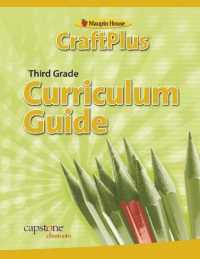- ホーム
- > 洋書
- > 英文書
- > Religion / Ethics
Full Description
This work tells the story of a community of fourth-century monks living in Egypt. The letters they wrote and received were found within the covers of works that changed our understanding of early religious thought - the Nag Hammadi Codices. This book seeks to contextualise the letters and answer questions about monastic life. Significantly, new evidence is presented that links the letters directly to the authors and creators of the codices in which they were discovered.
Contents
Preface
Figures
Abbreviations
Prologue: Searching for the Footprints
1 Focus and Structure
2 Turning to the Source Material
3 Social Theories and Monks
1 Background to the Letters
1 Turning to the Letters
2 Reviewing the Evidence
3 Identifying Monastic Material—Problems and Solutions
2 Fourth-century monasticism
1 The Development of Monastic Terminology
2 Christians as Individuals
3 Types of Monastic Living
4 Monastic Norms
5 Monks and Deviancy
6 Looking the part
7 The Monks of the Letters
8 Individual Lives
3 The Monastic Landscape
1 Late Antique Egypt—Geography
2 Population Size
3 The Location of the Monastic Community
4 Evidence from the Find Site
5 Internal Clues in the Letters
6 Monasteries and their Material Remains
7 The Local Pachomian Monasteries
8 The Monasteries of the Western Desert
9 Monastic Dwelling Places
10 Pachomian Domestic Arrangements
11 Evidence for Monastic Foodstuffs
12 Jars and Storage
13 Monasteries, Monastics and Books
4 The Early Monastic Economy
1 Monks and their Labours
2 Weaving
3 Property Ownership
4 Gifts from Patrons
5 Medicine and Ritual Texts
6 Creating an Income
7 Agricultural Work
8 Monks as Scribes
9 Monastic Trade and Travel
10 Travels for the Sake of the Monastic Economy
11 Economic Dealings in the Nag Hammadi Letters
5 Egyptian Monasticism and its Social Context
1 Power and Identity in Late Antique Egypt
2 Social Networking in Egypt
3 The World of the Fourth-Century Alopex Family
4 Evidence from Chenoboskia
5 Evidence in the NHC Letters
6 Interconnections and Social Ties
6 Monastic Travels
1 Moving About in the Late Roman Empire
2 Travel to and from the Monastery
3 Monastic Tourism
4 Monks on the move
5 Authorised Travel
6 Moving Away—Travel to the Edges of Egypt and Beyond
7 Movement and Monastic Literature
7 A Monastic Manuscript Culture
1 Literacy in Early Monasteries
2 Material Evidence for Monastic Literacy and Education
3 Classical Education
4 Language Choice in the Letters
5 Codices as Material Artefacts
6 The Books of Fourth- and Fifth-Century Monks
7 Monastic Codices—the Archaeological Evidence
8 Dating Codices
9 Coptic Codices and their Owners
10 Evidence for Book Ownership in the Cartonnage
11 Monastic Book Production
Scriptoria
12 Bookbinding
13 Papyrus as a Commodity
14 Scribes of the Nag Hammadi Codices
Epilogue: Footprints Uncovered
Appendix1: Translations of Monastic and Christian letters from the Cartonnage Material
Bibliography
Index








